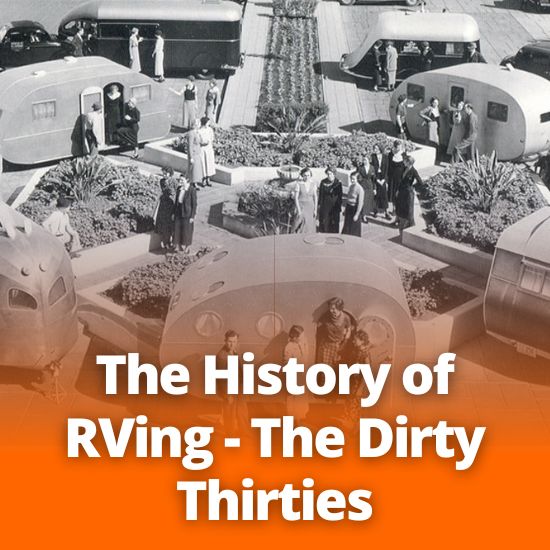
The History of RVing - The Dirty Thirties
We’re going to pause from looking at RVs and their tech to briefly explore camping as a concept and how it was becoming more prominent and mainstream.
First, by Royal Decree of King George V: Canada’s National Parks Act was passed in 1930, officially, legally, eternally setting land aside for the “benefit, education, and enjoyment” of Canadians present and future. Alberta also passed its own Provincial Parks and Protected Areas Act in 1930, with Aspen Beach Provincial Park being established in 1932 as the first of many preserved parks and rec areas. Like a runaway train, Canada hurtled towards outdoor expedition with the force of a maelstrom, including the founding of the Canadian Camping Association (CCA) in 1936 as a non-profit national federation “dedicated to the growth, development, and promotion of organized camping” nationwide.
Finally, everyday Canadians would be able to enjoy an outdoors experience. Different levels of government began opening free campgrounds to encourage tourism (as well as preserving the natural environment by containing campers to specific areas). Privately owned campgrounds also started popping up, offering better amenities and activities for those willing to pay.
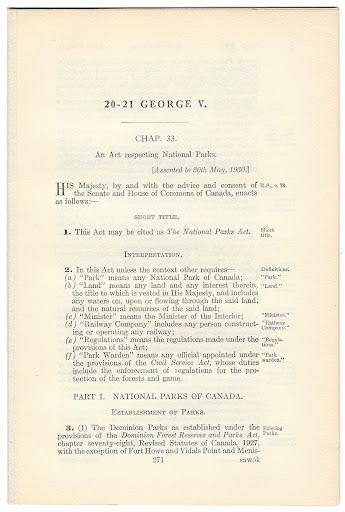
Of course, the 30s were essentially the beginning of what would be decades of political upheaval. While the first twenty years of the 1900s saw the upswing and downfall of World War I and all its challenges, the 30s crashed into the Great Depression with World War II following at its heels. From 1939 to 1945 pretty much every leisure activity was diminished, as every bit of fuel and material was shuttled towards the war effort.
However, never let it be said that humans won’t procrastinate even the most crucial of things, because where others were focused on surviving the Great Depression and later WWII, many still managed to eke through RV developments throughout the decade.
Gone Camping just got taken to a whole new level.
In a total contrast to the Depression, glamping took a turn starting in the 30s with RVs arriving on the scene sporting dinettes, separate bedrooms, and utility hook-ups. And despite the world’s state of economic disaster, Arthur Sherman (remember him?) really got going with his Covered Wagon Company, a wildly successful business when others were fading from existence. In 1936 they were the largest producer in the American wing of the industry, selling approximately 6,000 units.
But, could it be because trailer travel was a better economic choice in the long run? With train and hotels higher priced, perspective travelers chose trailers as their ticket to freedom. Manufactured trailers were sold in the thousands, and could often be bought for $300 USD (approximately $4,700 USD today). Although you’d be hard pressed to find any still around oddly.
We can definitely blame the media for the trailer boom (at least partially). A variety of magazines, everything from Popular Mechanics to Woman’s Home Companion, plied the benefits of RVing. With all this hype trailer companies started to overproduce for a perceived future number of sales in 1937. Oversaturation of the market slowed the success of these companies (including Covered Wagon), further impeded by the slowly recovering economy and strikes in the auto industry. Trailer companies crawled to the finish line in 1942 when sales flourished again with the US military purchasing trailers by the dozen to use as military housing.
Trailers as permanent housing for civilians also kicked off, as many owners were forced to park them for longer durations, forming ‘permanent address’ trailer parks in a way. After WWII, (and yes we’re getting into the 40s, but it’s relevant) young families getting on their feet in the post-war world used travel trailers as easy, affordable housing. Overall, trailer construction had remained the same (as a small, traveling home), but this evolved as they became more permanent houses. If we jump forward another few decades, we can see a great example of this is the 1953 film The Long, Long Trailer, starring Lucille Ball and Desi Arnez; a comedy film about a newlywed couple who butt heads over buying a house or being nomadic RVers.
We’ll talk more about that divergence of the RV industry when we get to the fifties, but we’ll make the brief note that while these companies started making wider trailers in the 30s they’re very uncommon today. In fact, most vintage travel trailers you’ll see are from the late fifties onward.
The 30s became the decade of the house trailer as they rapidly became a more preferable choice than tents. A wide range hit the market from hundreds of different manufacturers with everything from teardrops, to massive, palatial trailers (huge even compared to modern specimens); but the tent trailer really started to go out of style this decade, with more than 20,000/year solid-body units produced. Many kits were also sold to allow home builders to convert light car chassis into trailers.
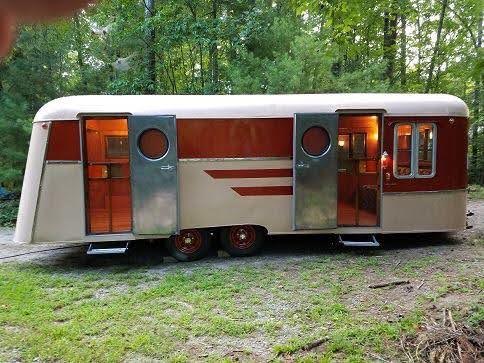
(A 1930s Silverdome with dual entry)
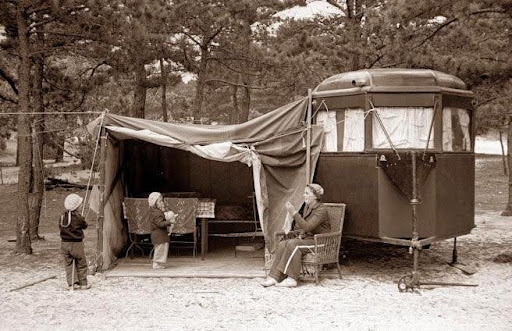
(Vardo with tent/awning added for extra outdoor space)
But what did some of these trailers look like?
The Gilkie Tent Trailer
We featured this trailer in the 20s as well (check it out here) but to refresh: it was made of canvas stretched over folding frames kept upright by a central ridgepole between. Tent corners held up created a roof and sides with pull-out “drawers” to make the two double beds, central aisle space in the middle, and window opposite the door under which a cooking area was set.
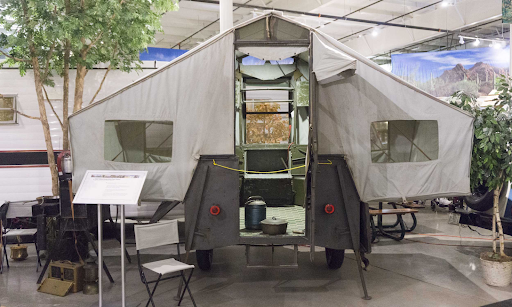
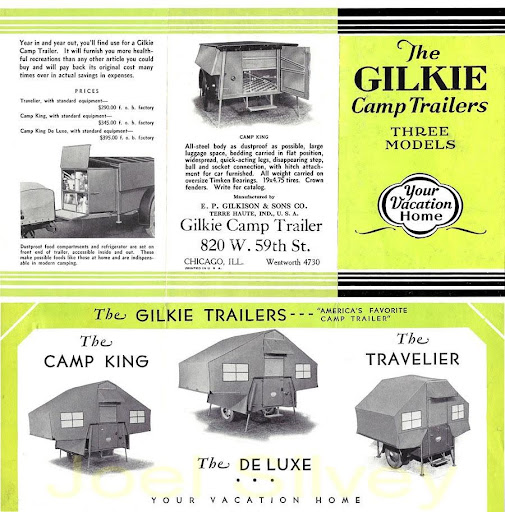
1934 Schult Trailers
Wilbur Schult (a former dealer for Covered Wagon Trailers) was credited as the first man to begin broadscale RV manufacturing, opening a shop in Elkhart, Indiana, with Walter O. Wells and becoming one of the largest manufacturers in the world by 1940 with plants in the USA, as well as Canada and New Zealand. They’re recognized as being the first manufacturer to extend the standard unit width from 7.5 feet to 8, with 7-foot ceilings, and build a full steel frame for even their base level products. Schult Trailers ended up designing an optional prototype “air conditioning system” which circulated air throughout the whole trailer over a vault of ice.
There’s a lot to say about Wilbur Schult and Schult Trailers, but we’ll save that for another time.
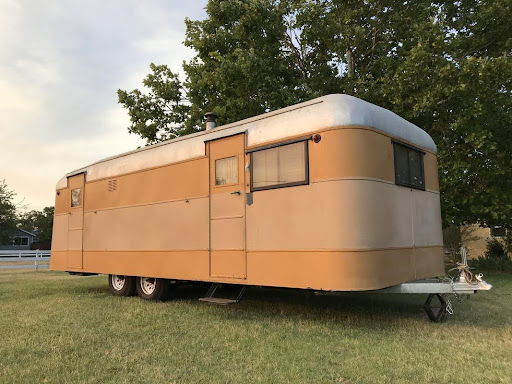
(1946 Schult Luxury Liner, ‘Tin Can Tourists’)
1935 Road Chief
Designed by Hawley Bowlus, this was an ultra-light aluminum trailer (the first of its kind) weighing only about 1,100 lbs and able to be pulled by a small car. It was constructed in a method very similar to that of aircrafts with panels of riveted, airplane-grade aluminum screwed to galvanized steel tubing that was acetylene welded together.
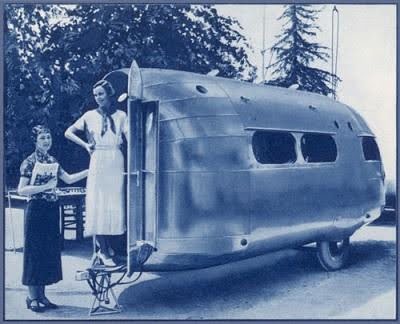
1936 Airstream Clipper
Closely related to the Road Chief, is the Clipper, a similarly airstream-esc, aluminum bodied tubular trailer with space to sleep four, a water tank, dinette, galley, and electric lights. It was marketed boasting its advanced insulation and ventilation system, and an “air conditioning” component that used dry ice, although without testing it today we can’t say whether this or the ice vault of Schult Trailers was the better design!
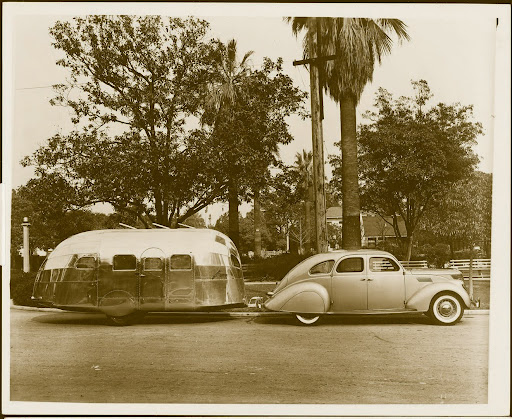
So bigger trailers, new A/C technology, steel frames, and aircraft style builds. What will the 40s bring I wonder?
